Punjab
About Punjab
Located in the northwestern part of India, Punjab means the land of five rivers. Known for its cuisine, culture and history, Punjab is visited by tourists who want to enjoy its vibrant culture and food.
The fertile land of farms and forts, Punjab has been aptly nicknamed the ‘Smiling Soul of India’ where you will always see smiles on the faces of the inhabitants who take pride in their religion and culture. Though the state does not have any significant adventure activity to offer, yet entertainment is guaranteed!
There are many Forts in the state that tell the tale of the land’s past. The Golden Temple, The Wagah border, The Jallianwala Bagh, The Sheesh Mahal are some of the major tourist attractions in Punjab. The list becomes endless as every street of Punjab is an attraction in itself; each region of Punjab has a different story and unique beauty hidden inside it.
Chandigarh

Chandigarh, a union territory that is the capital of both Punjab as well as Haryana, is India’s first planned city. A traditionally Punjabi city at heart with a healthy dose of modernity, Chandigarh’s food and gedi culture (a leisure drive or ride the city) is what the capital is really known for. Located at a distance of 265 km from Delhi, Chandigarh is one of the favourite weekend road trip destinations of from the capital city of India and other major cities but also acts an important staging point when one heads to destinations in Himachal Pradesh and Jammu and Kashmir.
Things to Do
Rock Garden
Located in sector 1 of Chandigarh, The Rock Garden is a massive open-air exhibition hall that displays sculptures made from urban and industrial wastes that have been designed and executed by Nek Chand, a former Road Inspector in Chandigarh. It is located between the famous Sukhna Lake and the Capitol Building and is a spectacle that is must-visit! Also known as Nek Chand’s Rock Garden, this massive 40-acre garden is a colourful mosaic of art pieces and sculptures. The rock garden is situated at Uttar Marg in Sector 1, 1.5 km from Sukhna Lake if you are travelling by cab. Buses and auto-rickshaws are also easily available.
The exhibition area of Rock Garden is divided into three different phases that have different types of installations and embellishments in them. Each phase deals with a different type of installations and walking through them is a true delight. From terracotta pots, light fixtures, and even broken toilet pots, the creator – Mr. Nek Chand has truly redefined art and craft!
The Rock garden was built in the year 1957 by officer Nek Chand single-handedly in his spare time and has become a long-standing symbol of imagination and novelty in the city. Having a total of about 5,000 statues within its bounds, the Rock Garden in Chandigarh is a true example of ‘Best From Waste’
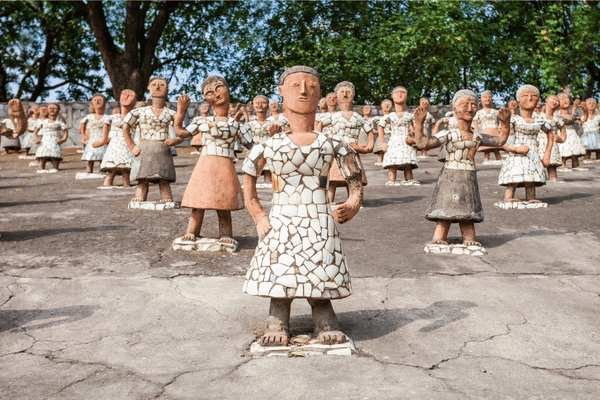


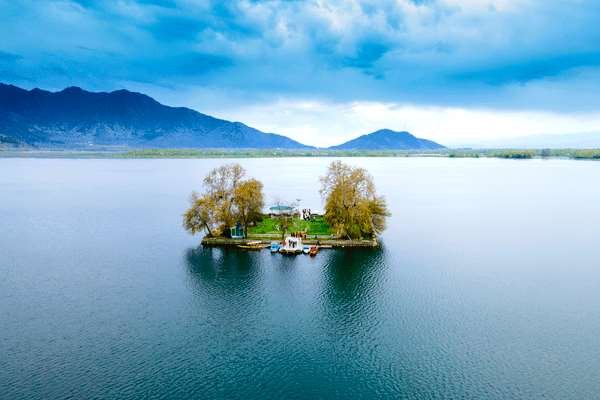
Sukhna lake
Nestled at the foot of Shivalik Hills, Sukhna Lake in Chandigarh paints a pretty picture. Stretching for a distance of 3 sq. km., Sukhna Lake is a man-made lake and is the only one of its kind in the city created in the year 1958 by damming the seasonal Sukhna Choe (Stream) that flows down the Shivalik Hills. With its pristine blue water, the lake serves as a perfect location for a stream of morning joggers and walkers who can also enjoy the fresh air. In fact, the architect of Chandigarh – India’s first planned city – Le Corbusier claimed that this lake would be the centre of wellness pursuits for the residents. The promenade in front of the lake is frequented by walkers and joggers who carry out their exercise regimes here. Moreover, it also has one of the longest rowing channels in the country that host the Asian Rowing Championships. The best way to enjoy a tour of the Sukhna Lake is to go on a lazy boating tour on it.
Apart from serving as a delight for artists and photographers, the lake is also a great spot for sports activities such as rowing, trampoline jumping along with the recent addition of a Solar Cruise. It is home to several species of fish and migratory birds such as Siberian ducks and cranes. Bounded by a golf course and the famous Rose Garden, the lake offers a mesmerizing escape to its visitors at all times of the day.
Pinjore Gardens
Pinjore Gardens is a beautiful Mughal Garden made in 17th Century India located in the city of Pinjore, in the district of Panchkula, Haryana. The garden expands over a massive area of 100 acres and is a beautiful place to unwind with nature in the ever-growing concrete city. The Pinjore garden is also known as Yadvinder Garden which is famous all over the world for its well-maintained greenery, refreshing fountains and mesmerising water bodies. Tourists from all over the world visit the Pinjore gardens to experience this Mughal creation that India has very proudly and carefully maintained.
Pinjore Gardens are a good illustration of terrace gardens in India. During Baisakhi, between April and June, the Garden serves as the venue of the annual Mango Festival. It doesn’t just have a vast expanse of beautiful flora but also houses a mini zoo, an area dedicated to historic places, a serene Japanese garden, a splendid nursery and some areas that serve as picnic spots. So, the Gardens have enough for everyone, be it kids or adults. Many believe that the Pandava brothers rested her for a while during their exile. The best time to explore the gardens is in the evening time. The entire garden is lit up after sunset in such a way that the ambience of the garden changes completely.

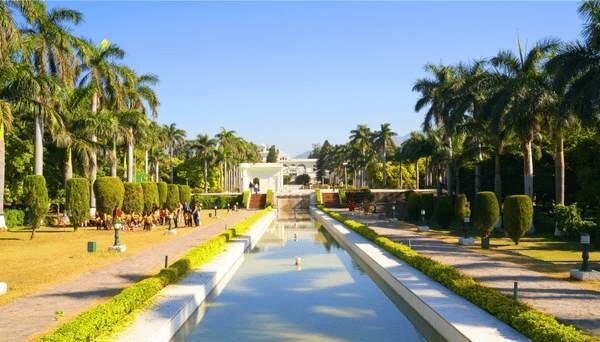


Government Museum and Art Gallery
Government Museum and Art Gallery in Chandigarh is one of the most prominent museums of India that speaks of the Indian history and partition. Established in August 1947, the museum is known for its rich collection of paintings, artefacts, and sculptures. Moreover, its unique architecture which was designed by Le Corbusier is highly revered. On 6th May 1968, Dr MS Randhawa, then chief commissioner of Lahore inaugurated the museum.
The mission of this institution is to encourage appreciation of values embedded in art and bring it close to the lives of people through interpretation of its rich collection and innovative programs. Located in the centre of the town, it offers the view of the Shivalik ranges in the backdrop. Visiting it can give you in-depth knowledge in the form Gandharan sculptures, Pahari and Rajasthani miniature paintings.
Nishat Bagh
The Nishat Bagh is a 12 terraced garden located near Srinagar’s famous Dal Lake. It is the second-largest Mughal garden in Kashmir after Shalimar Bagh. Popularly known as “Garden of Bliss”, it has a splendid Mughal central water channel with several fountains, which is surrounded by tall Chinar trees.
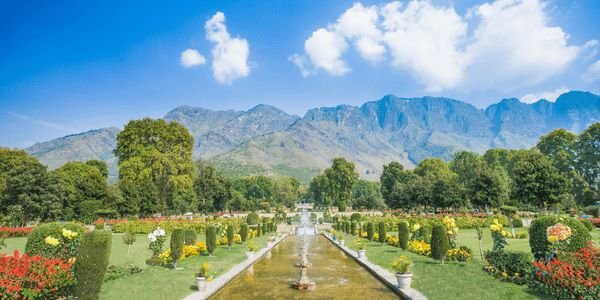
Amritsar
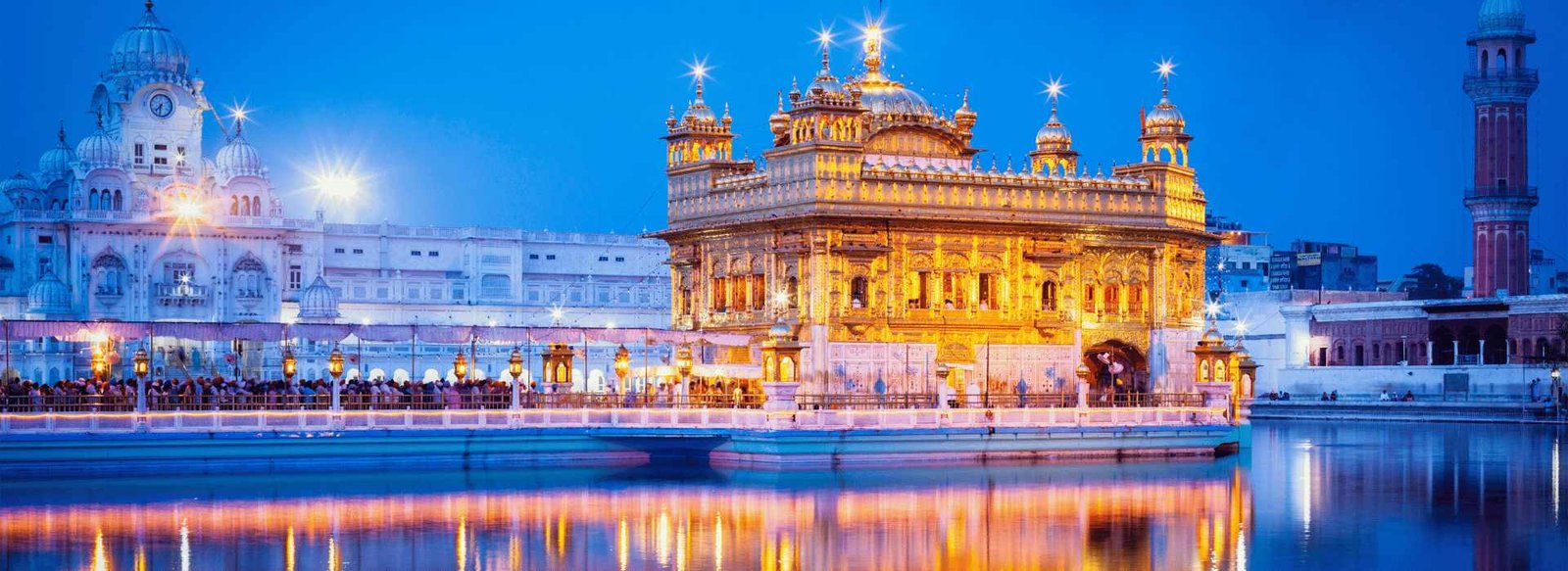
Home of the glorious Golden Temple, the iconic city of Amritsar, portrays the heroic character of the Punjab. A day in this peaceful city starts with the spiritual prayers from Gurudwaras. The original name of first the ancient lake, then of the temple complex, and later the surrounding city, meaning “pool of ambrosial nectar.”
Amritsar is the spiritual and cultural centre of the Sikh Religion. Baisakhi festival brings out Amritsar’s resplendent face with its finest food, clothes and merry-making. This place is also famous for its Jallianwala Bagh massacre and its proximity to Wagah Border. The satiating food and generous dollops of legendary Punjabi hospitality further connive to cast a spell upon the visitor. From the Operation Blue Star in the Golden Temple to the tragedy of the Jallianwala Bagh massacre, Amritsar has seen the worst of situations and yet emerged like a phoenix through testing times. Amritsar today is a thriving city with active trade and tourism industries. One of the most agriculturally productive cities of India, Amritsar is well connected with most of the important cities of India.
Golden Temple
One of the most spiritual places in India, the Golden Temple, also known as Sri Harmandir Sahib, is the holiest shrine in all of Sikhism. Located right in the heart of Amritsar and being easily reachable from any part of the city, the stunning golden architecture of the temple and the daily Langar (community kitchen) attract a large number of visitors and devotees each day. The temple is open to devotees of all faiths and serves over 100,000 people free food from all walks of life.
The main Temple housing the shrine is a small part of the vast complex known as Harmandir Sahib or Darbar Sahib to the Sikhs. The spiritual focus is the tank, the Amrit Sarovar, which surrounds the glistening central shrine. Around the edges of the compound, there are more shrines and monuments. The Sikh Museum is located inside the main entrance clock tower which shows the oppression endured by the Sikhs at the hands of the Mughals, the British and the Indian Government of 1984. The Golden Temple is indisputably one of the most exquisite attractions in the world.

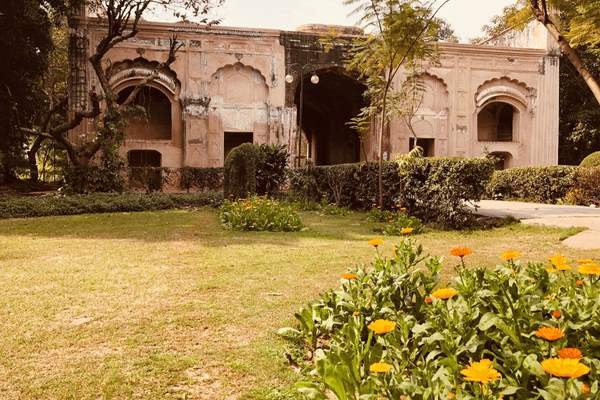

Jallianwala Bagh
Located near the famous Golden Temple of Amritsar, Jallianwala Bagh is a public garden that also houses a memorial to commemorate the massacre of peaceful celebrators by the British forces. Spread over 6.5 acres of land, Jallianwala Bagh is associated with one of the saddest days in Indian History when thousands of innocent people were killed on the orders of General Dyer as they gathered for a peaceful celebration of Baisakhi. The place has now been turned into a beautiful park and is managed by the Jallianwala Bagh National Memorial Trust.
There is a memorial tablet at the entrance which serves as a record of history. The tragic incident left a deep scar on the country, and a memorial was constructed post the independence for the innocents who lost their lives in this devastating incident. Established by the government of India in 1951, the massacre memorial was inaugurated by Dr Rajendra Prasad on 13th April 1961.
A number of structures are present inside the premises which resound of the atrocities that occurred here. These include a wall which still bears the marks of the bullets that were hurled blindly at the civilians and a well in which many people jumped to save themselves from the onslaught of the bullets. It is estimated that over a 1000 Hindus, Muslims and Sikhs lost their lives in this brutal assault. a narrow alley of immense historical importance passes through here. An air of eerie calm still lingers over the Jallianwala Bagh and gives one a feeling of indescribable sadness and peace.
Partition Musuem
The Partition Museum in Amritsar is a museum housing a collection of stories, memoirs, art and artefacts that hold the memory of the time before, during and after the partition of British India. Located at the Town Hall in Amritsar and developed by the Arts and Cultural Heritage Trust (TAACHT), the museum is a part of the newly inaugurated Heritage Street at Amritsar, which begins from the Golden Temple and ends at the Town Hall.
The exhibits at the Partition Museum include newspaper clippings, photographs as well as personal items that were donated by people who had witnessed and lived during the Partition. TAACHT aims to establish the Partition Museum as a world-class physical museum dedicated to the memories of the partition of the sub-continent in 1947. The museum is devoted primarily to the victims & survivors, and their lasting legacy.
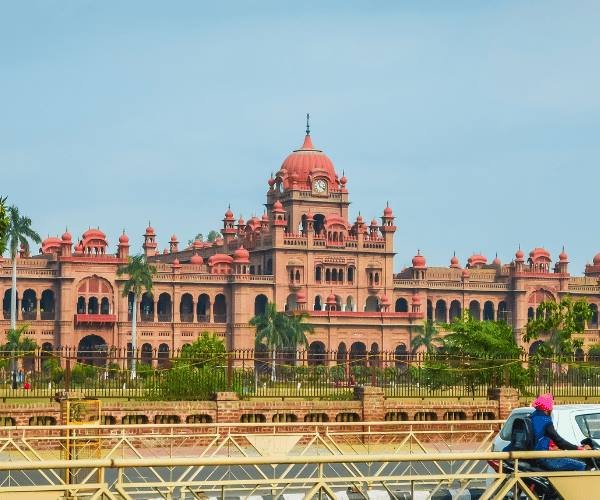

Wagah/Attari Border
Located at a distance of 22 km from Lahore, Pakistan and 28 km from Amritsar in India, the Wagah Border marks the boundaries between Indian and Pakistani borders, running along the Grand Trunk Road. The Wagah Border Ceremony or the Beating Retreat Ceremony, held every day, is the prime attraction. Every evening, just before sunset, the soldiers from the Indian and Pakistan military meet at this border post to engage in a 30-minute display of military camaraderie and showmanship.
This ceremony includes the closing of the international gates and lowering the flags of both countries. The flag ceremony has been conducted by the Indian Border Security Force and Pakistan Rangers since 1959. People also partake in entertainment as a display of national pride for the thousands of people who come here every day. During the build-up to the ceremony, the crowd engages in chanting the Indian national anthem, rounds of applause and Bollywood-style dancing on Hindi songs.
About Delhi
The capital of India, Delhi is a cosmopolitan city with a historic old Delhi and the modern New Delhi. From historical monuments to crowded shopping malls, from an extensive network of the modern metro system to Delhi University campus, Dilli has multiple personalities and is considered the city with a heart. The narrow, winding lanes and by lanes of old Delhi are a testament to the former Mughal rule. Old Delhi houses one of the country’s oldest and busiest market – Chandni Chowk.
Take time to explore historical monuments such as the Red Fort, Jama Masjid, Humayun’s Tomb and Purana Qila if you want to explore the Mughal History. Delhi has famous temples scattered all across the city, a few noteworthy ones being the Akshardham Temple, the Lotus Temple (also known as the Bahai Temple), and the ISKON Temple. Central Delhi is the concentration of the country’s political power, and the must-visit places here include the Rashtrapati Bhawan on Raisina Hill, the Rajpath, and the India Gate. The best place to visit this area is in the evening, as all the buildings are lit up, and you can see the Amar Jawan Jyoti at India Gate shining brightly.
Delhi is a shopper’s paradise with some colourful bazaars and upscale markets. The wide variety of markets in Delhi ensure that travellers go back home with double the luggage they came with! People in Delhi love to eat, and tourists will find themselves spoilt for choice between the multitude of dishes on offer at every corner of every street. From kebabs and tikkas to Chhole Bhature, Delhi is a melting pot of diverse cultures, and this fact is reflected in the culinary palette of the city.

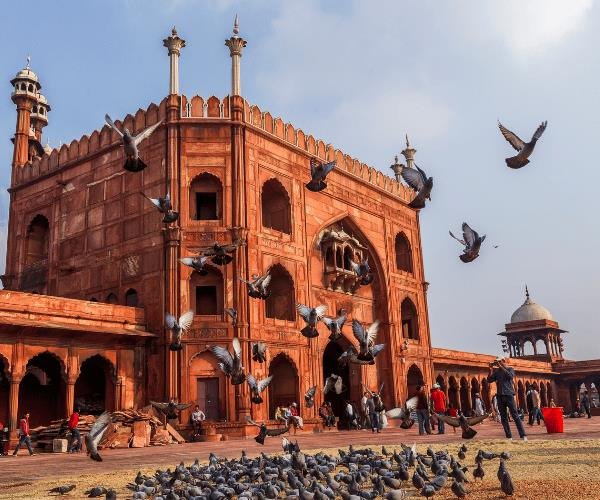
Things to Do (Sightseeing and Visits)

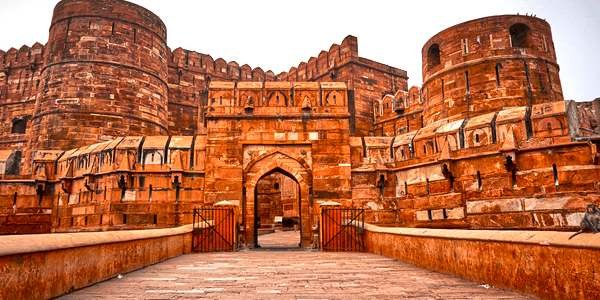
Red Fort
The Red Fort is a historical fortification in the old Delhi area. Shah Jahan constructed it in the year 1639 as a result of a capital shift from Agra to Delhi. Used as the main residence of the emperors of the Mughal dynasty, this imposing piece of architecture derives its name from its impregnable red sandstone walls. In addition to accommodating the emperors and their households, it was the ceremonial and political centre of the Mughal state and the setting for events critically impacting the region.
Formerly known as Quila-e-Mubarak or the Blessed Fort, the Red Fort lies along the banks of the river Yamuna, whose waters fed the moats surrounding the fort. It was a part of the medieval city of Shahjahanabad, popularly known today as ‘Old Delhi’. The entire fort complex is said to represent the architectural creativity and brilliance of Mughal architecture. With so much history and heritage associated with it, the Red Fort is one of the most popular monuments in India and a major tourist attraction in Delhi. It became a UNESCO world heritage site in 2007. The Archaeological Survey of India is at present responsible for the security and preservation of this magnificent monument.
Jama Masjid
The ‘Masjid-I Jahan-Numa’ or Jama Masjid in Delhi is the largest mosque in India built by Mughal Emperor Shah Jahan. The mosque hosts thousands of pilgrims each year on the holy occasion of Eid to offer special Namaz in the morning. With a capacity of twenty-five thousand people in the courtyard, Jama Masjid extends for about 1200 square meters in area with three gateways, four towers and two minarets which are forty meters high. Syed Abdul Ghafoor Shah Bukhari, an Imam from Uzbekistan, inaugurated the mosque. Unfortunately, non-Muslims are not allowed inside the Masjid during Namaz offerings.
Jama Masjid is situated in the older part of Delhi, now called Chandni Chowk and surrounded by beautiful Mughal structures. It took a huge construction cost of one million rupees at the time, five thousand workers and six years (1650-1656) to complete. To reach the entrance one needs to climb 121 steps which are filled with food and bookstalls in the evening. The massive central dome is an outstanding example of Islamic architecture. J Sadaullah Khan who was the Wazir (prime minister) during Shah Jahan’s rule supervised the construction of the mosque. Literally meaning “World Reflecting Mosque.”, the mosque was the last of Shah Jahan’s impressive collection of architectural undertakings, after the Taj Mahal and the Red Fort.
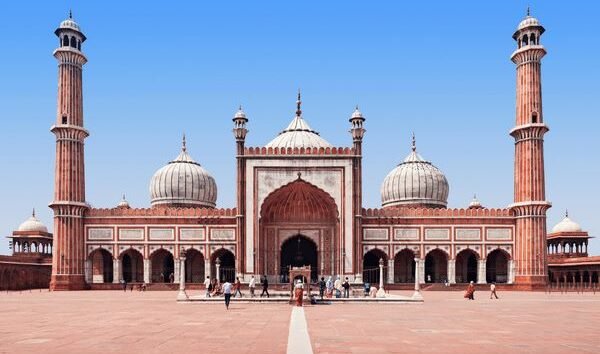
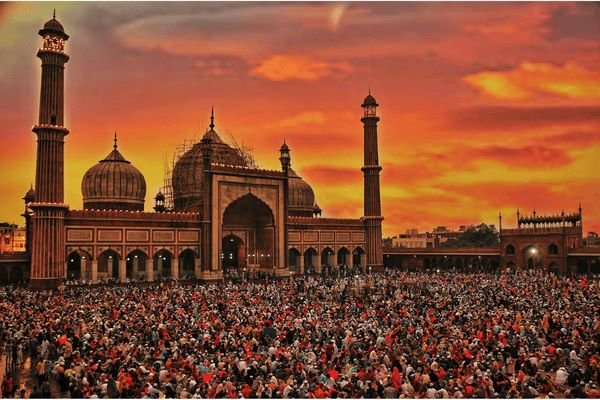
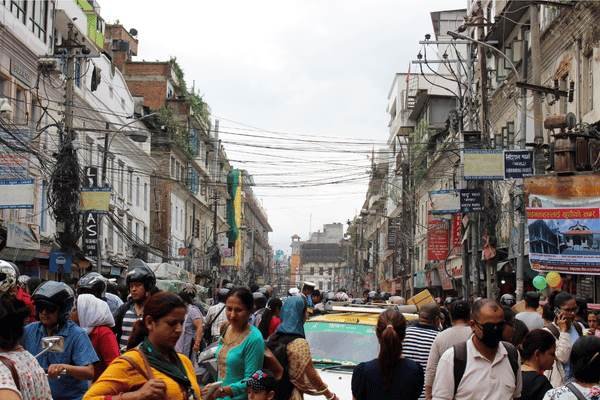
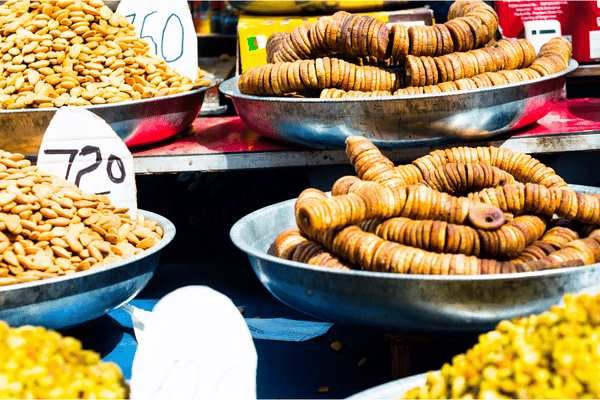
Chandni Chowk
One of the oldest markets in Old Delhi, Chandni Chowk is Old Delhi’s main thoroughfare which is a chaotic wholesale market lined by hawkers and porters offering full medieval bazaar experience. It is an important historical site renowned for the availability of every kind of goods as well as food. It was constructed in the 17th-century b the Mughal ruler of India Shah Jahan. It is situated opposite the Red Fort and provides a view of the Fatehpuri Mosque.
Crisscrossed by narrow streets with shops jostling for space, Chandi Chowk gives a feel of old Delhi shopping. Since the 17th-century era, this places is rightly called a “shoppers paradise” in Delhi. During the reign of Shah Jahan, there was a tree-lined canal running through its centre, reflecting the moon. Hence, the name “Chandni Chowk” came to being which means “moonlight place”. Shopping at Chandni Chowk is fun as the market is distributed in several streets and these narrow streets are inundated with vibrant varieties of clothes, perfumes, electronic items, jewellery, candles, idols of deities and lifestyle goods. The market deals in everything that shoppers might think to buy for oneself and as well as for home. As this is a wholesale market, one can get huge discounts on most of the items. These shopping streets is heaven for retailers too. Apart from shopping, this place is equally famous for its eateries, street food, and Indian snacks. It has been aptly said for this barrage of noise, colour and smell,
Humayun's tomb
As the name suggests, Humayun’s tomb is the final resting place of the Mughal Emperor Humayun. Located in the Nizamuddin East area of Delhi, it is the first garden-tomb in the Indian subcontinent. This splendid piece of architecture was commissioned for construction by Humayun’s chief consort Empress Bega Begum in the year 1569-70 and is one of the very few structures that used red sandstone on such a massive scale at that time. The design of Humayun’s tomb is a typical Mughal architecture with Persian influences and was conceptualised by Persian architect Mirak Mirza Ghiyath. Owing to its magnificent design and illustrious history, Humayun’s Tomb was featured in UNESCO’s World Heritage List in the year 1993.
The architectural genius of Humayun’s tomb is hard to miss. This magnificent tomb sits in the middle of a huge, ornate Mughal Garden and its beauty is only enhanced during the winter months. Situated on the banks of the River Yamuna, this mausoleum is also home to the remains of many other Mughals, including his wives, son and descendants of the later Emperor Shah Jahan, as well as numerous other subsequent Mughals.
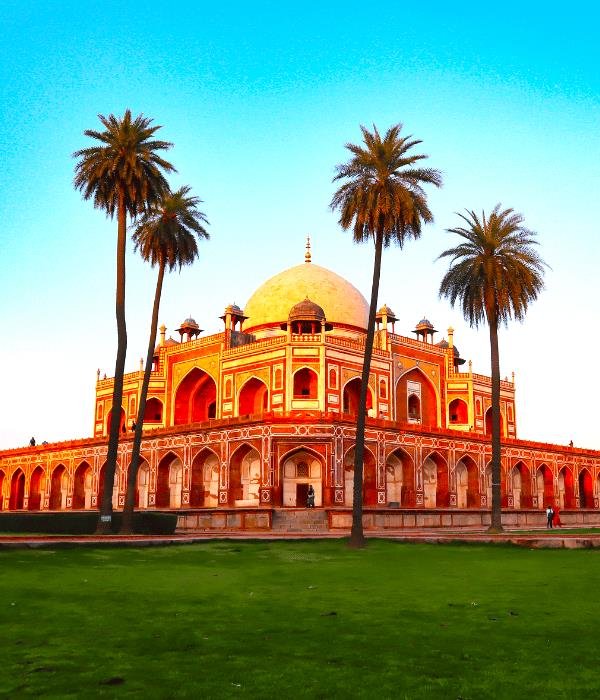
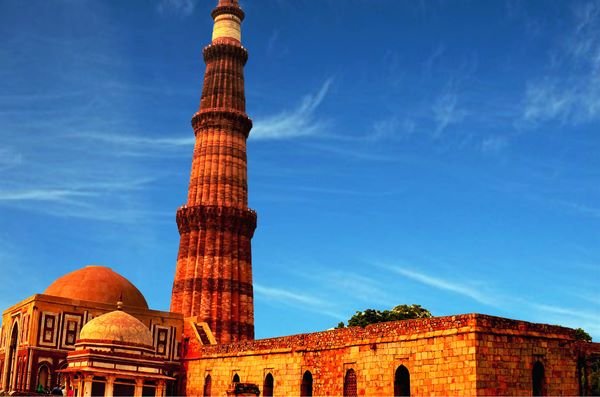
Qutub Minar
Qutub Minar is a minaret or a victory tower located in Mehrauli area of Delhi. With the height of 72.5 metres (238 ft), the UNESCO World Heritage Site of Qutub Minar is the second tallest monument of Delhi. Its construction was started in 1192 by Qutb Ud-Din-Aibak, founder of Delhi Sultanate after he defeated the last Hindu Ruler of Delhi. He constructed the basement, after which the construction was taken over by his son-in-law and successor Iltutmish who constructed three additional stories. The fourth and fifth storeys were built by Firoz Shah Tuglak.
Jantar Mantar
Located in the Parliament Street, south Connaught Circle of New Delhi, Jantar Mantar is a vast observatory built to help and improve upon the studies of time and space as was known. It was built by Maharaja Jai Singh in the year 1724 and forms a part of a collection of five such observatories located in Jaipur, Ujjain, Varanasi and Mathura.
Delhi’s Jantar Mantar consists of 13 architectural astronomy instruments which can be used to compile the astronomical tables and to predict the movement and timings of the sun, moon and planets. The intelligent construction and placement of these instruments allowed the observer to note the position of heavenly bodies with their naked eye alone.
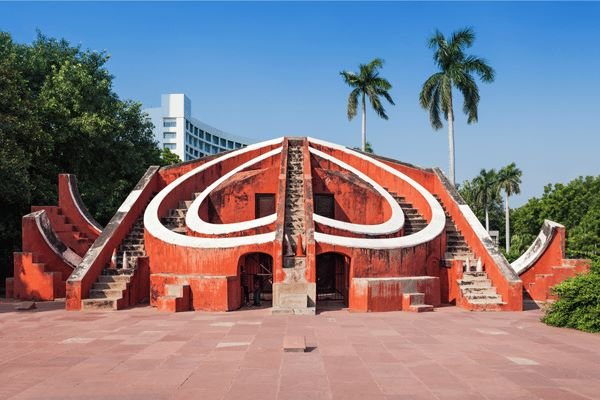
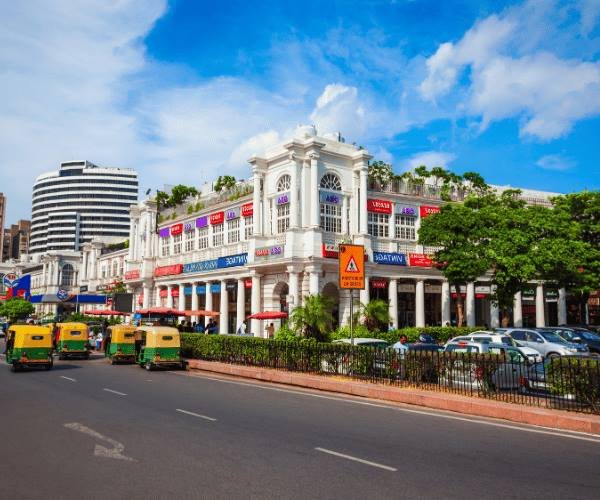
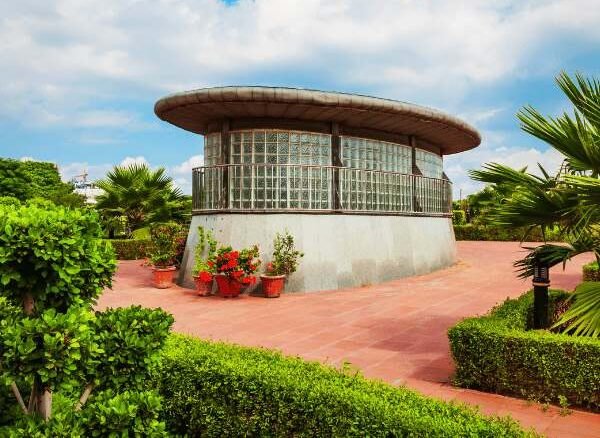
Connaught Place
Connaught Place or ‘CP’ as it is more commonly known is a massive commercial and financial centre in New Delhi. Named after the Duke of Connaught and Strathearn, this confusing market complex houses almost all famous international chain stores, famous food chains, restaurants and bars. Connaught Place has one of the largest national flags in the country. This circular, greying whitewashed structure has two concentric circles; the inner circle which has blocks A to F and the outer circle which has blocks G to N. The Connaught Place is also the ultimate place to experience the vibrant nightlife of Delhi housing some of the most famous bars and restaurants. Being one of the most popular after dark destinations, no visit to Delhi is complete without a visit to the Connaught Place.
Connaught Place has some of the best colonial buildings in the city. Always bustling with people, it is dotted with Contemporary art galleries, antique theatres like Regal Cinema and toy stores. Delhi’s first ice cream parlour, first toy store and first art gallery were all opened at this place. It is the ninth most expensive office market, costlier than Dubai, downtown Boston and Shanghai. Be it Indian or western fashion, khadi garments, accessories or various Indian handicrafts; one can get everything here. Connaught Place or CP is also a favourite among the city’s party people. The nightlife here is lively with a myriad choice of some of the bars, pubs, sports bar, lounges, cafes and restaurants. Whether you are from Delhi or just visiting, you can dance the night away in one of the swanky nightclubs here. Connaught Place is a major shopping and entertainment centre apart from being a place to experience the diverse culture of the city.
Gurudwara Bangla Sahib
Gurudwara Bangla Sahib is a Sikh temple as well as tourist places in Delhi. Built to commemorate the visit Guru Har Krishan, the eighth Sikh guru in 1664, this magnificent shrine was built by Sikh General Sardar Bhagel Singh in 1783, who supervised the construction of nine Sikh shrines in Delhi in the same year during the reign of Mughal Emperor Shah Alam II. Operating for all 24 hours, the Gurudwara is an example of the large-hearted nature of Sikhs. This place of solace is flocked by more than a thousand people in one single day.
The complex of Gurudwara Bangla Sahib has a main prayer hall, a holy Sarovar or lake, higher secondary school, a hospital, Baba Baghel Singh Museum and a library within its premises. People visiting here get ‘Kada Prasad’ and free langar or ‘community meals’ are served at a particular time. Head needs to be covered while entering, shoes have to be deposited near the entrances and feet are washed in warm water before entering. It also has a ‘Yatri Niwas’ or House for tourists. The Paath and Shabads (the sacred chants) that go almost for 24 hours connects you directly to the divine power.
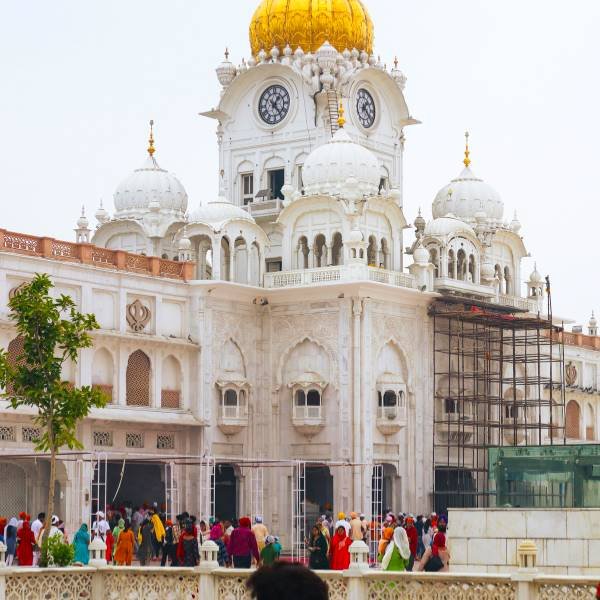

Rajghat
Rajghat is a memorial in Delhi where Mahatma Gandhi, Father of the Nation, was cremated followed by his assassination in the year 1948. The cenotaph commemorating his memory is a simple black marble structure that sits amid a beautiful garden. The place is visited by locals as well as foreigners and various delegates to pay their homage to the Father of the Nation. A prayer is held every Friday, the day he died at Rajghat.
Rajghat also has samadhis or memorials of notable leaders if India Jawaharlal Nehru, Sanjay Gandhi, Indira Gandhi, Rajiv Gandhi, Lal Bahadur Shastri, Choudhary Charan Singh, Giani Zail Singh, Jagjivan Ram, Shankar Dayal Sharma, Devi Lal. Chandra Shekhar and I.K. Gujral. Raj Ghat, translating to King’s Bank is giving reference to its location on the bank of Yamuna River.
Rajpath
Rajpath, which means the “King’s Way:, is a ceremonial avenue that is located in the heart of New Delhi, the capital state of India. Rajpath runs from the Rashtrapati Bhavan on Raisina Hill on one end to the National Stadium on the other end and passes through Vijay Chowk and India Gate. Also popularly referred to as ‘The Royal Road’, Rajpath is surrounded by beautiful and lush green gardens, rows of trees and canals on both sides. It was constructed by Sir Edwin Lutyens, who was instrumental in designing and building New Delhi and was the main architect of numerous monuments including the India Gate and Rashtrapati Bhavan. Rajpath was built to provide an unhindered view of Delhi, as Lutyens wanted to have a panoramic sight from the Viceroy’s palace.
It is bordered by the North and South Blocks of the Secretariat Building on its either sides. The long lanes have trees running and the gardens located around Rajpath make the area more colourful. The entire area is well maintained and is home to delegates. Rajpath is undoubtedly one of the most important roads that New Delhi houses and is also the yearly site for the Republic Day Parade that takes place on 26 January. The Republic Day Parade showcases a vast display of Indian arms and ammunition, as well as other sophisticated weaponry on hold for the security of the country. At the same time, the rich and distinct culture of the nation is presented to the millions of onlookers who throng either side of the Rajpath.
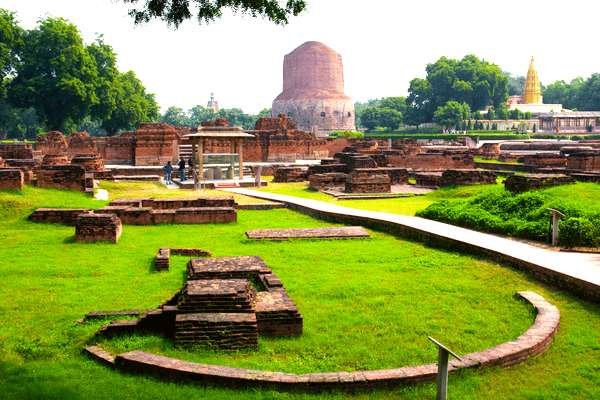

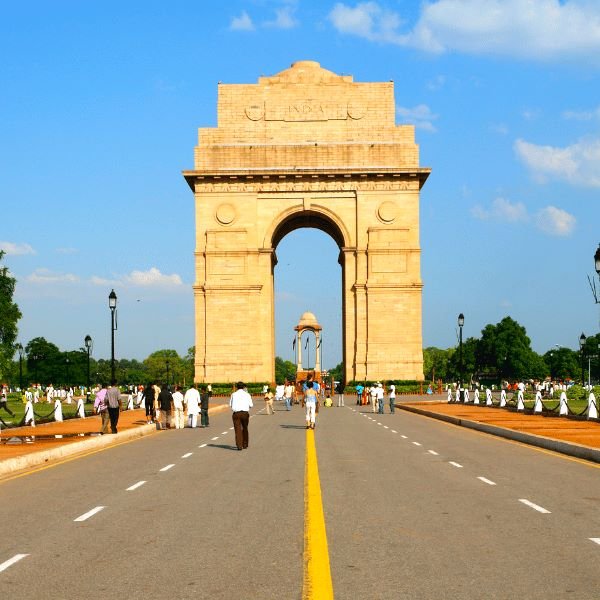
India Gate
The All India War Memorial, popularly known as the India Gate, is located along the Rajpathin New Delhi. The imposing structure of India Gate is an awe-inspiring sight and is often compared to the Arch de Triomphe in France, the Gateway of India in Mumbai and the Arch of Constantine in Rome. This 42-meter tall historical structure was designed by Sir Edwin Lutyens and is one of the largest war memorials in the country. India Gate is also famous for hosting the Republic Day Parade every year.
Dedicated to 82,000 Indian and British soldiers who died during the First World War and the Third Anglo-Afghan War, this monument has the names of 13,300 servicemen inscribed on its surface. The premises of India Gate also houses the Amar Jawan Jyoti, which is a kindled structure right underneath the archway. Owing to its rich historical background and astonishing architecture, India Gate has become one of the most popular picnic spots in the city.
National Museum
Also known as the National Museum of India, the National Museum in New Delhi is one of the largest museums in India, situated on the corner of the Janpath and Maulana Azad Road. Established in 1949, the blueprints of the majestic repository were prepared by the Gwyer Committee set up by the Government of India in 1946. Today, the museum boasts of possessing a whopping 200,000 artworks, both Indian and foreign, and is maintained by the Ministry of Culture, Department of India. Covering an extensive range of products from the prehistoric times to modern works of art, the museum traces the rich cultural heritage of nations across the world, from over 5000 years ago.
The museum also houses National Museum Institute of the History of Arts, Conservation and Museology which was added as a different section in 1983. Since 1989, this section runs different courses in History of Arts, Conservation and Museology for Masters and Doctoral degrees. Besides, the repository boasts of 4th and 5th century B.C. relics, dating back to the times of Buddha and the Harappan Civilization, in addition to numerous wood carvings, paintings, sculptures, murals, textiles, armoury etc. The two-storeyed building has clearly segregated chambers to display antiques of different periods. It covers all departments including Archaeology, Decorative Arts, Jewellery, Manuscripts, Textiles, Numismatics, Epigraphy, Central Asian Antiquities, Anthropology, Pre-Columbian American and Western Art Collections. The museum is an unparalleled blend of the glorious past and the wondrous present.
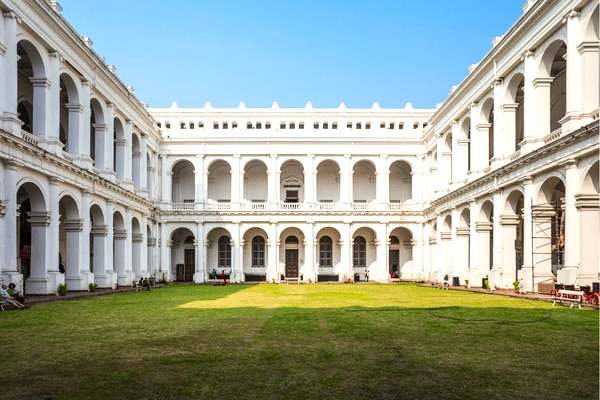


Khan Market
Regarded as one of Delhi’s most posh and classy place to shop, Khan Market of Delhi is one of the oldest and the costliest markets in India. Favoured by diplomats and Delhi’s influential, this market is renowned mainly for its fashion boutiques, amazing bookstores, opticians, homewares & cafes. For those who love stationery, the place offers handmade papers, lovely paper mache ornaments and other festive decorations. From the showrooms of the best brands to the restaurants providing lip-smacking food; the retail location is a paradise for both shopaholics and foodies. The visit to Khan Market is incomplete without tasting Khan Chacha’s tikkas and seekhs. Trust us, Delhites crave for these!
Established in 1951, the market has successfully held the essence of its original structure even in the times of rapid modernization. If you need to hang out late at night, Khan Market is the place for you as remains open till 12:00 AM. A real estate firm Cushman & Wakefield rated Khan Market as the world’s 21st most expensive retail high street.
Lodhi Garden
Located near the Safdarjung tomb and Khan Market of Delhi, the Lodhi Garden is a luscious garden that houses the tombs of Sayyid ruler Mohammed Shah and Lodhi king Sikandar Lodhi. The construction of this great work of architecture took place under the Lodhi reign sometime in the 15th century. In addition to encompassing the final resting place of two great leaders, the Lodhi Garden also has the Shisha Gumbad and Bara Gumbad within its perimeter. The architecture here shows a mix of work by Sayyidis and Lodhis and is the epitome of magnificent engineering that echoes of Delhi’s illustrious history. Currently, this place is maintained by the Archaeological Survey of India.
Lodhi Garden was once known as ‘Lady Willingdon Park’, but was renamed after India gained independence from the British. The contrast of sombre mausoleums against the lush greenery of the gardens makes it a favourite among tourists and locals alike. Along with being an architectural site, it has also become a hub of morning and evening exercise routine for people living nearby.
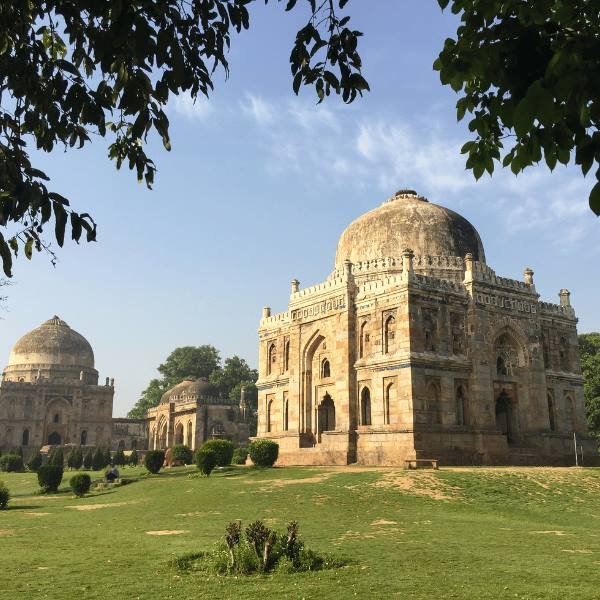
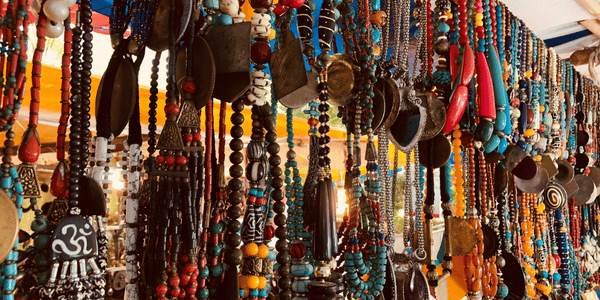

Dilli Haat
Designed to invoke the ambience of a traditional village fair, Dilli Haat is every shopper’s paradise and a foodie’s haven. There are three Delhi Haats in Delhi: Pitampura, Janakpuri and INA, with INA being the most popular one. Delhi Haat INA is located in the commercial centre of South Delhi, bang opposite the INA Market. Run by Delhi Tourism and Transportation Development Corporation (DTTDC), the market offers a plethora of traditional crafts and handloom products including rosewood and sandalwood carvings, embellished camel hide footwear, sophisticated fabric and drapery, gems, beads, brassware, metal crafts, and silk and wool fabrics, copperware, chandeliers, cane & jute products etc. In addition to this, the market has savoury lip-smacking food cuisines from varied parts of India- momos from Nepal, Bamboos hot chicken from Nagaland, Kahwa & Kebabs from Jammu, Pooranpoli from Maharastra etc.
Dilli Haat is a forum to bring together rural art and folk culture; it has an open-air theatre where cultural events are performed on a daily basis. Above all, it is a fascinating panorama of art, craft and culture and a perfect spot to capture all those candid pictures you always wanted.
The ISKCON Temple
The ISKCON Temple, also known as the Hare Rama Hare Krishna Temple, is a Vaishnav temple dedicated to Lord Krishna and Radharani in the form of Radha Parthasarathi. It was established in the year 1998 by Achyut Kanvinde and is located in the Hare Krishna Hills, in the East of Kailash area of New Delhi. ISKON, whose actual name is Sri Sri Radha Parthasarathi Mandir, was formed in the year 1995 by then CM if Delhi Sahib Singh Verma and Lt. Smt. Sushma Swaraj. The outer complex is embellished with intricate carvings and stonework and has many shops and a beautiful fountain. Inside the main sanctum, the idols are adorned with rich clothes and jewellery.
The temple complex is also a centre for learning Vedic sciences and many devotional lectures and addresses are arranged for the benefit and spiritual nerve of devotees.

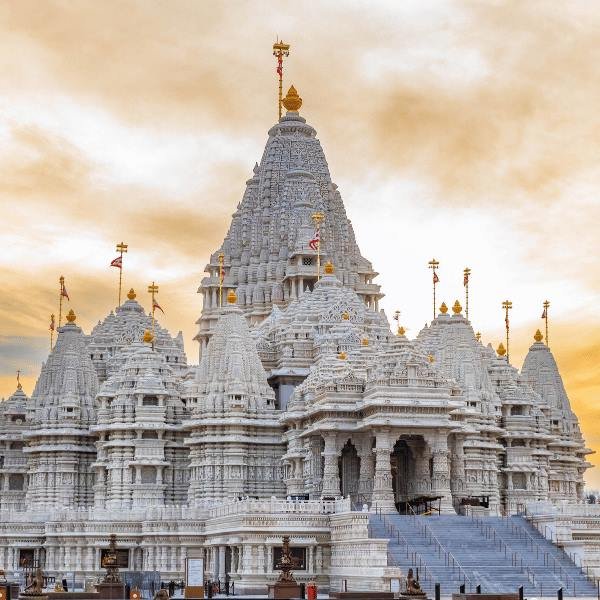
Akshardham Temple
An epitome of Indian culture, spirituality, and architecture, Akshardham Temple is a famous Hindu temple and a spiritual-cultural complex. Also known as Swaminarayan Akshardham, it is dedicated to Lord Swaminarayan. Akshardham has made its way to the Guinness Book of World Records as the World’s Largest Comprehensive Hindu Temple.
The Akshardham Temple is known for its stunning architecture. It has eight ostentatiously carved mandapams while timeless Hindu teachings and flamboyant devotional traditions find their place on the temple’s walls. The centrepiece, i.e. Lord Swaminarayan’s Murti along with that of 20,000 deities, significant personalities in Indian history and sages showcase the essence of Indian architecture, traditions and timeless spiritual thoughts.
Akshardham complex is home to India’s largest step well which is a host to the mesmerising water show; an open garden, Narayan Sarovar, various expeditions, and rituals. The complex is not less than a paradise for spiritual seekers.

